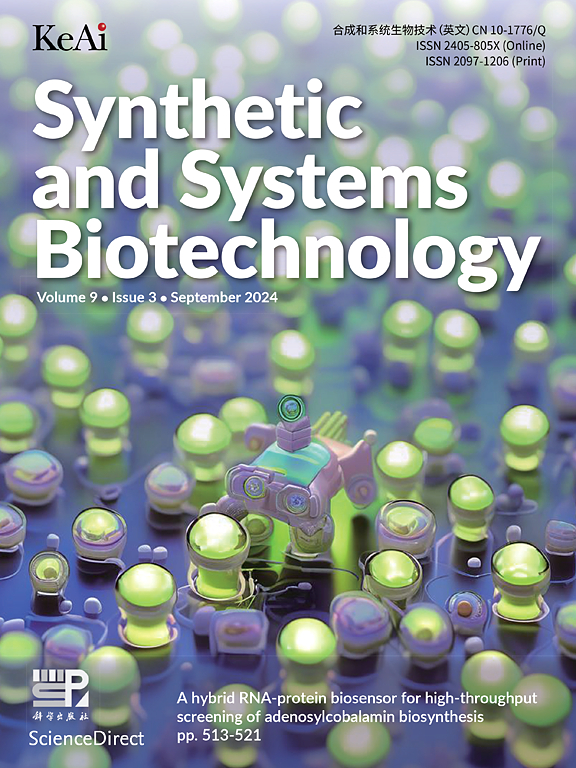利用大肠杆菌无细胞蛋白合成系统高产产功能性Kir2.1离子通道及其表征
IF 4.4
2区 生物学
Q1 BIOTECHNOLOGY & APPLIED MICROBIOLOGY
引用次数: 0
摘要
内纠偏钾(Kir)通道家族在调节细胞钾(K+)平衡中起关键作用,影响肌肉、神经和免疫功能。Kir通道由Kir亚基的同源或异源四聚体组成,每个四聚体都包含两个跨膜结构域。与Kir通道的精确生物物理表征相关的挑战限制了我们对这类重要分子的理解。此外,Kir通道固有的复杂的多跨膜结构域在产生足够数量的准确表征方面存在重大障碍,进一步限制了我们对这些通道的了解。在本研究中,我们选择Kir2.1作为模型分子,利用大肠杆菌无细胞蛋白表达系统(CFPS)在肽表面活性剂A6K的存在下合成Kir2.1,这有助于促进可溶性产物的产生,实现α-螺旋构象,并稳定膜蛋白(MPs)。采用Ni-NTA亲和层析柱纯化Kir2.1,产率约为1.5 mg/mL。圆二色光谱(CD)测定证实纯化后的Kir2.1具有典型的α-螺旋结构。微尺度热泳实验(MST)证实了Kir2.1与盐酸羟肉桂酸和ML133的结合能力,抑制了Kir2通道的选择。重组kir2.1脂质体对K+表现出特异性通道活性,利用电压敏感荧光染料Oxonol VI监测浓度梯度驱动的钾内流。这项工作有助于提高离子通道的制备、表征和药物高通量筛选的效率。本文章由计算机程序翻译,如有差异,请以英文原文为准。

High-yield production and characterization of functional Kir2.1 ion channel using E. coli cell-free protein synthesis system
A family of inwardly-rectifying potassium (Kir) channels plays a key role in the regulation of cellular potassium (K+) balance, affecting muscle, nerve and immune function. Kir channels are comprised of either homologous or heterologous tetramer of Kir subunits, each of which contains two-transmembrane domains. The challenges associated with the precise biophysical characterization of Kir channels have limited our understanding of this important class of molecules. Moreover, the complex multi-transmembrane domains inherent to Kir channels present significant obstacles in producing sufficient quantities for accurate characterization, further constraining our knowledge about these channels. In this study, we selected Kir2.1 as a model molecule and utilized an Escherichia coli cell-free protein expression system (CFPS) to synthesize Kir2.1 in the presence of peptide surfactant A6K, which aids in promoting the soluble production, achieving α-helical conformations, and stabilizing membrane proteins (MPs). Ni-NTA affinity chromatography column was employed to purify Kir2.1, achieving a yield of approximately 1.5 mg/mL. Circular dichroism spectroscopy (CD) measurements confirmed that the purified Kir2.1 exhibited typical α-helix structures. Microscale thermophoresis (MST) assays demonstrated the binding capability of Kir2.1 with Hydrocinnamic Acid and ML133 hydrochloride, Kir2 channel selection inhibitory. Recombinant Kir2.1-liposomes exhibited specific channel activity to K+ using the voltage-sensitive fluorescent dye Oxonol VI to monitor the concentration gradient-driven potassium influx. This work contributes to enhancing both the efficiency of preparation, characterization and drug high-throughput screening of ion channels.
求助全文
通过发布文献求助,成功后即可免费获取论文全文。
去求助
来源期刊

Synthetic and Systems Biotechnology
BIOTECHNOLOGY & APPLIED MICROBIOLOGY-
CiteScore
6.90
自引率
12.50%
发文量
90
审稿时长
67 days
期刊介绍:
Synthetic and Systems Biotechnology aims to promote the communication of original research in synthetic and systems biology, with strong emphasis on applications towards biotechnology. This journal is a quarterly peer-reviewed journal led by Editor-in-Chief Lixin Zhang. The journal publishes high-quality research; focusing on integrative approaches to enable the understanding and design of biological systems, and research to develop the application of systems and synthetic biology to natural systems. This journal will publish Articles, Short notes, Methods, Mini Reviews, Commentary and Conference reviews.
 求助内容:
求助内容: 应助结果提醒方式:
应助结果提醒方式:


